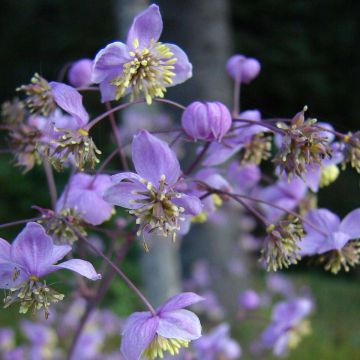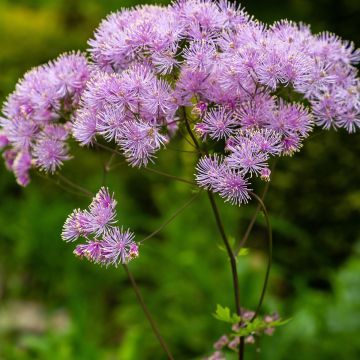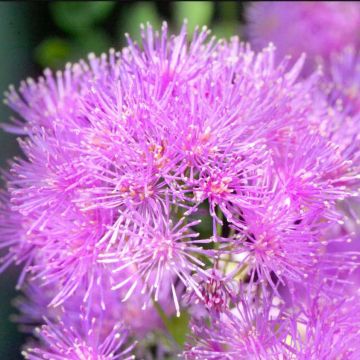

Thalictrum aquilegifolium Fairy Wings - Meadow-rue


Thalictrum aquilegifolium Fairy Wings - Meadow-rue


Thalictrum aquilegifolium Fairy Wings - Meadow-rue
Thalictrum aquilegifolium Fairy Wings - Meadow-rue
Thalictrum x aquilegifolium Fairy Wings
Meadow Rue
Well-developed plant and planted as soon as received. Now we just have to wait for it to establish itself.
Louise, 07/10/2023
Why not try an alternative variety in stock?
View all →This plant carries a 12 months recovery warranty
More information
We guarantee the quality of our plants for a full growing cycle, and will replace at our expense any plant that fails to recover under normal climatic and planting conditions.
From €5.90 for pickup delivery and €6.90 for home delivery
Express home delivery from €8.90.
Does this plant fit my garden?
Set up your Plantfit profile →
Description
Thalictrum aquilegifolium 'Fairy Wings' is a variety of Meadow-rue compact with generous summer flowering in beautiful mauve pink to purple pink. This pretty semi-shade perennial develops flowering stems crowned with large inflorescences with a fluffy appearance composed of small flowers with numerous prominent stamens, resembling small fluffy pompoms. The finely cut green-blue-silver foliage, which strongly resembles that of columbines, is very attractive. An ideal plant for lightening up semi-shady borders, in humus-rich and moist soil.
Thalictrum Fairy Wings is a recent horticultural creation. Its wild ancestor, the columbine-leaved meadow-rue (Thalictrum aquilegifolium), is native to damp and shady mountain meadows in Europe and Asia. It belongs to the Ranunculaceae family, just like anemones, clematis, and... columbines. This large herbaceous perennial with a rhizomatous root system can sometimes be slow to establish, but its beauty is worth the wait.
The 'Fairy Wings' variety stands out for its lower habit and its very beautiful fluffy dense flowers in purple pink. At maturity, the plant reaches about 50 cm (20in) in all directions. Its green-blue leaves, 15 to 30 cm (6 to 12in) long, are divided into obovate leaflets on either side of the central vein and with undulate edges. The resemblance to the foliage of garden columbines is quite striking. Appearing in June-July, the flowers are arranged in large panicles forming clouds of fluffy flowers. The spherical flowers, 8 to 10 mm (0in) wide, are composed of violet petals from which emerge long radiating stamens. The stems that bear them are strong enough to do without staking. The above-ground vegetation, deciduous, dries up in autumn and regrows in spring.
This lovely Thalictrum Fairy Wings will find its place in the middle of borders. Its flowering stems are perfect for making summer displays, with roses or peonies, for example. It thrives in slightly sunny or semi-shady areas of the garden. A damp and deep soil allows it to develop vigorously, but it is not afraid of summer heat, as long as it is watered from time to time in the late afternoon. It pairs very well with lilies, as well as with ferns, hostas, bellflowers, meadowsweets, rodgersias, and perennial geraniums.
Tip: Dare to use tall giant plants to add structure and volume in the garden. The tallest ones give volume and lightness against a dark background of hedges or conifers. Those of intermediate height will complement tall borders, such as those with giant dahlias.
Report an error about the product description
Flowering
Foliage
Plant habit
Botanical data
Thalictrum
x aquilegifolium
Fairy Wings
Ranunculaceae
Meadow Rue
Cultivar or hybrid
Other Thalictrum - Meadow Rue
Planting and care
Thalictrum Fairy Wings should be planted in spring or autumn, in the middle of the flower bed, in partial shade, on soil rich in humus or compost, deep and moist, but well drained. Water during dry weather and spread mulch on the soil to maintain moisture in summer. Do not prune the plants to the ground after flowering, as new shoots will only emerge in late spring the following year. Therefore, it is advisable not to cut the plant down in autumn, so as not to forget its location the following spring. Remove faded flowers to prevent excessive self-seeding. Perfectly hardy, Thalictrum can withstand temperatures as low as -21°C (-5.8°F). Overall very robust, it can be prone to powdery mildew in hot and dry weather. Gastropods sometimes cause some damage in spring.
Planting period
Intended location
Care
-
, onOrder confirmed
Reply from on Promesse de fleurs
Summer flowering perennials
Haven't found what you were looking for?
Hardiness is the lowest winter temperature a plant can endure without suffering serious damage or even dying. However, hardiness is affected by location (a sheltered area, such as a patio), protection (winter cover) and soil type (hardiness is improved by well-drained soil).

Photo Sharing Terms & Conditions
In order to encourage gardeners to interact and share their experiences, Promesse de fleurs offers various media enabling content to be uploaded onto its Site - in particular via the ‘Photo sharing’ module.
The User agrees to refrain from:
- Posting any content that is illegal, prejudicial, insulting, racist, inciteful to hatred, revisionist, contrary to public decency, that infringes on privacy or on the privacy rights of third parties, in particular the publicity rights of persons and goods, intellectual property rights, or the right to privacy.
- Submitting content on behalf of a third party;
- Impersonate the identity of a third party and/or publish any personal information about a third party;
In general, the User undertakes to refrain from any unethical behaviour.
All Content (in particular text, comments, files, images, photos, videos, creative works, etc.), which may be subject to property or intellectual property rights, image or other private rights, shall remain the property of the User, subject to the limited rights granted by the terms of the licence granted by Promesse de fleurs as stated below. Users are at liberty to publish or not to publish such Content on the Site, notably via the ‘Photo Sharing’ facility, and accept that this Content shall be made public and freely accessible, notably on the Internet.
Users further acknowledge, undertake to have ,and guarantee that they hold all necessary rights and permissions to publish such material on the Site, in particular with regard to the legislation in force pertaining to any privacy, property, intellectual property, image, or contractual rights, or rights of any other nature. By publishing such Content on the Site, Users acknowledge accepting full liability as publishers of the Content within the meaning of the law, and grant Promesse de fleurs, free of charge, an inclusive, worldwide licence for the said Content for the entire duration of its publication, including all reproduction, representation, up/downloading, displaying, performing, transmission, and storage rights.
Users also grant permission for their name to be linked to the Content and accept that this link may not always be made available.
By engaging in posting material, Users consent to their Content becoming automatically accessible on the Internet, in particular on other sites and/or blogs and/or web pages of the Promesse de fleurs site, including in particular social pages and the Promesse de fleurs catalogue.
Users may secure the removal of entrusted content free of charge by issuing a simple request via our contact form.
The flowering period indicated on our website applies to countries and regions located in USDA zone 8 (France, the United Kingdom, Ireland, the Netherlands, etc.)
It will vary according to where you live:
- In zones 9 to 10 (Italy, Spain, Greece, etc.), flowering will occur about 2 to 4 weeks earlier.
- In zones 6 to 7 (Germany, Poland, Slovenia, and lower mountainous regions), flowering will be delayed by 2 to 3 weeks.
- In zone 5 (Central Europe, Scandinavia), blooming will be delayed by 3 to 5 weeks.
In temperate climates, pruning of spring-flowering shrubs (forsythia, spireas, etc.) should be done just after flowering.
Pruning of summer-flowering shrubs (Indian Lilac, Perovskia, etc.) can be done in winter or spring.
In cold regions as well as with frost-sensitive plants, avoid pruning too early when severe frosts may still occur.
The planting period indicated on our website applies to countries and regions located in USDA zone 8 (France, United Kingdom, Ireland, Netherlands).
It will vary according to where you live:
- In Mediterranean zones (Marseille, Madrid, Milan, etc.), autumn and winter are the best planting periods.
- In continental zones (Strasbourg, Munich, Vienna, etc.), delay planting by 2 to 3 weeks in spring and bring it forward by 2 to 4 weeks in autumn.
- In mountainous regions (the Alps, Pyrenees, Carpathians, etc.), it is best to plant in late spring (May-June) or late summer (August-September).
The harvesting period indicated on our website applies to countries and regions in USDA zone 8 (France, England, Ireland, the Netherlands).
In colder areas (Scandinavia, Poland, Austria...) fruit and vegetable harvests are likely to be delayed by 3-4 weeks.
In warmer areas (Italy, Spain, Greece, etc.), harvesting will probably take place earlier, depending on weather conditions.
The sowing periods indicated on our website apply to countries and regions within USDA Zone 8 (France, UK, Ireland, Netherlands).
In colder areas (Scandinavia, Poland, Austria...), delay any outdoor sowing by 3-4 weeks, or sow under glass.
In warmer climes (Italy, Spain, Greece, etc.), bring outdoor sowing forward by a few weeks.


























































